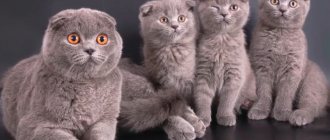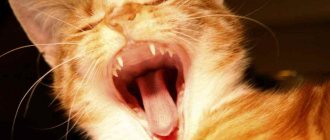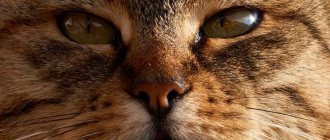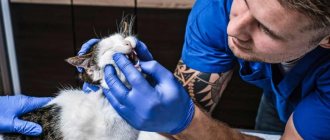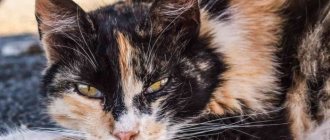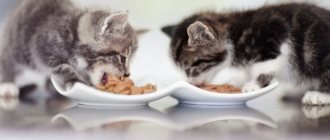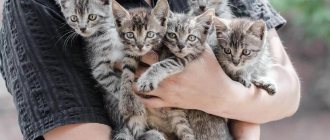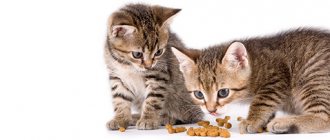If a person is interested in purchasing newborn fold kittens, then it is important to find out information on how to correctly determine whether a Scottish fold kitten is lop-eared. After birth, it is difficult to distinguish whether a cat is a fold cat or not. Unscrupulous breeders try to sell straight-eared pets to unknowing buyers for a high price. To avoid being deceived, it is recommended to study the main differences and recommendations for choosing a cat.
Straights and folds
The Scottish Fold cat breed, characterized by ears with an abnormal structure, became known in the first half of the 60s of the 20th century.
It appeared a little earlier, but did not immediately deserve the attention of scientists. In the 60s Thanks to scientific research, it was found that lop ears appear due to a gene mutation.
By crossing two identically fold-eared individuals, as scientific experiments have shown, it is almost impossible to get healthy kittens with the same unusual ears. The offspring are weak, non-viable, and have many genetic defects.
To get a healthy Scottish Fold kitten, breeders resort to tricks. They cross a fold-eared individual (Scottish Fold) with a straight-eared Scot (Scottish Straight). These breeds are considered related, but at the same time they are independent. The offspring from such a union turns out strong and healthy.
The birth of a viable kitten that meets the standards of the Scottish Fold breed is possible if its parents have the following characteristics:
Why is September a healthy and happy month for cats? Why does a cat bang its head against you in the evenings? 5 “exotics” that are best not to have at home What should you do if your cat sleeps with its eyes open?
- flexibility of the tail (the key to a healthy spine);
- uniformity of color, which should be the same in females and males;
- having ear folds.
The offspring born from the “correct” parents can either have the ear structure typical of Scottish Folds or be straight-eared, like Scottish Straights. It is not possible to determine this in the first weeks of a baby’s life. Fold does not appear until kittens reach three weeks of age. The ears of straights and folds at this stage of development have the same appearance.
This is interesting: Do cats grow whiskers?
Calicos, tortoiseshells
It is known that predominantly cats are born this way, and a male tri-colored individual is a rare occurrence and without the possibility of procreation. Tortoiseshell Scottish Folds are distinguished by alternating red and black spots.
Color variations are possible, for example, lightening, then areas of the coat will be blue and cream. Breeders strive to produce “turtles” with uniform coloring and a symmetrical arrangement of spots.
Calicos are rare among Scottish Folds, but the cats look very impressive. They are recognized by their white background and colored spots. There may also be bright colors and weakened ones. Diluted Calico - there is much more white base.
Eye color depends on the base color and the distribution of spots on the head and face. In any case, a bright and shining color is welcome.
Calico cats are prized for their diversity of offspring. The name of the color in translation is “patchwork”, which fully describes the appearance of the animal.
External signs of lop ears
A fold-eared kitten has structural features of the entire body, and not just the ears. These include:
- The nose is without humps, which can be determined by touch.
- The tail is smooth, without humps or knots.
- Wide muzzle.
- Round head.
- Small cheeks.
- Wide eye set.
- Large chest.
- The legs and tail are shorter and larger than those of their straight-eared counterparts.
- Plush wool.
External signs of fold-eared cats
Interesting! Fold cats are long-haired - Highland Folds, and short-haired - Scottish Folds.
Types of British and Scottish cats
Highland fold
Scottish fold
Tabby
Tabby is a pattern that is formed due to the special coloring of the hairs. The guard coat is divided into areas with varying pigment intensities. This effect is called ticking.
There are several types of tabby Scottish Fold cats.
Tiger or mackerel - there is a longitudinal dark line on the back and upper part of the tail, and dark stripes on the sides. A very popular drawing.
Marble is a bright and memorable pattern of wide and non-straight stripes, which is formed by darkened wool. There are a number of dots in the abdomen area, and a blurred butterfly pattern on the shoulders. Three fuzzy stripes along the spine are required.
Spotted tabby - rounded spots on the sides, and a dark stripe with breaks on the back. Sometimes this pattern alternates with lines.
The background can be anything, even the color points on the colored areas are tabby. The brighter the pattern, the more valuable the Scottish Fold color. These cats have a dark outline around the nose and eyes. Light areas and white spots are undesirable. The eye color is in harmony with the main background and can be orange or copper.
Lop or not?
When the kitten reaches 3 weeks of age, signs of lop ears begin to appear:
- in Straight, there is a hardening of the ear cartilages necessary to support the erect shape of the ear;
- In the Fold, the cartilage tissue does not harden, and the baby develops characteristic ear folds.
The owner of a Scottish Fold kitten should be aware that the ears of a Scottish Fold can rise with age. If they are straight in a three-week-old baby, there is no hope of their lowering. No matter what ears nature bestows on your pet, you should take care to create favorable conditions for its growth and development and choose the right food for the little Scotsman. Taking care of your baby will help him grow up strong, healthy and cheerful.
General information about fold-eared breeds
The history of the breed began in 1961, when an unusual white cat, Susie, was discovered on a farm in Scotland. The tips of her ears were bent forward and covered the upper part of the ear canal.
Susie later gave birth to kittens, two of which (a boy and a girl) inherited a genetic ear abnormality from their mother. The cat was castrated, so he did not leave offspring. And a cat named Sans was purchased by William Ross, who lived next door.
Ross brought geneticist Pat Turner into the matter and the two of them began breeding a new breed. Local British cats were used as partners for Sans, and as a result, 76 kittens were born. Of these, 42 were born with fold ears, and 34 with ordinary ears. This was enough to write an application for the creation of a new species. But life made its own adjustments.
In 1971, the registration of fold-eared cats was canceled. The animals exhibited diseases of the bones, spine, deformities of the limbs, deafness, a tendency to infectious diseases, and much more. It is possible that the story of the Scots could have ended there, but the situation was saved by geneticists from the USA. The problem was solved quite simply. All diseases turned out to be a legacy of the connection between homozygous cats (having the same alleles for lop-earedness). As soon as they began to be bred with straight-eared Scots (heterozygous), healthy kittens were born.
In 1978 the CFA gave the Scots show status. It took another 15 years to establish the standard of the new breed, which was called the Highland Fold (the first cats were long-haired). Later, shorthaired fold and straight-eared Scottish cats were recognized. They became Scottish and Highland Straights.
Recommendations for 1-3 months
Cats are naturally very clean creatures and do not normally require additional care. However, due to their age, kittens do not always cope with their hygiene procedures, and they need help with this.
Behind the eyes
Kittens need to regularly clean their eyes with a damp cotton pad (by the way, for Sphynx cats this is a different story altogether). You should be accustomed to such procedures from a very tender age and from the first days of the kitten’s stay in the apartment. Once a week, to prevent infections and cleanse your eyes more thoroughly, you can wipe them with a solution of boric acid (1/2 teaspoon of dry powder per glass of boiled water).
Nail trimming
Domestic kittens should only have the claws on their front paws trimmed. It is also worth accustoming to the procedure from the first days of life with the owners. Nails are trimmed approximately once a month - only the very tip is trimmed, no more than 2 mm, so as not to touch the blood vessels.
When to bathe and how?
Kittens are bathed only if necessary - if they are heavily soiled or if the presence of fleas is suspected. Fold-eared kittens are not allowed to bathe until they are two months old. Then bathe once every two to three months. Bath in warm water with special shampoo. After bathing, the coat must be dried to avoid hypothermia and colds.
The vast majority of kittens are afraid of the sound of water, so you should be careful with the pressure. It is better to fill the bathtub or basin with water in advance and water the baby from a ladle. For training, you can put rubber toys in the water.
The ears must be covered with cotton swabs during bathing. Oil drops are instilled into the eyes to prevent irritation of the mucous membrane in case of accidental contact with soapy water. The temperature should be about 36oC.
You need to wash all the products very carefully, because even after washing and drying the kitten will lick itself to remove the specific smell. Hot air is not used to dry the fur - only cold air at a distance of about half a meter from the kitten.
Ear cleaning
Ear inspection and cleaning should be done at least once a week. The auditory canal is carefully wiped from the outside with a cotton pad or cotton wool twisted into a flagellum.
It is better not to use cotton swabs - the kitten may pull away from the unpleasant sensations, and the swab itself may damage the ear, or the cotton swab from it may remain in the ear canal. Wax from the depths of the ear is not removed.
Scottish Fold coat care
Scottish Folds are naturally very clean and take care of their fur themselves. However, to reduce the clogging of the stomach with hairballs, you need to regularly, at least once a week, comb the animal with a special hair brush.
You can purchase them in special veterinary stores or pharmacies. For short-haired subspecies, a brush with short and frequent teeth is used; for long-haired counterparts, combs should have longer and sparse teeth.
Also, long-haired cats need brushing at least once every two to three days. During the molting period, brushing is carried out more often.
Signs of lop ears
The following rules will help you determine if a kitten is lop-eared with high accuracy and not fall for the bait of charlatans.:
- Choose a kitten that is at least three weeks old. The older he is at the time of purchase, the easier it will be to determine that he is lop-eared. It is advisable to buy a kitten at the age of two to three months.
- Folds not only have unusual ears, but also a slightly different body structure. Their muzzle is wider, with small cheeks, and their eyes are wider apart. The chest is usually larger, and the legs and tail are shorter and thicker.
- Feel the kitten's nose - there should be no hump on the bridge of the nose. You also need to feel the tail - there should be no humps or knots on it.
- Buy a fold-eared cat in the cold season. The fact is that folds have an interesting feature - in extreme heat, kittens’ ears rise a little.
© shutterstock
In addition, there are some general rules for choosing purebred kittens :
- The kitten must be completely healthy. His fur should be thick and silky, his eyes should be clear, and his tummy should be soft. His mood is also important - if the kitten is healthy, he will be playful.
- If in the future you want to breed purebred kittens or participate in exhibitions, then the kitten you buy must have a veterinary passport and pedigree.
- Since healthy offspring are obtained only by crossing a purebred cat with an ordinary one, you should ask who the kitten’s parents are.
- When buying a purebred kitten, be prepared to pay a high price for it. Such kittens are really expensive, and if the seller offers you to give them away cheaper, this is a reason to think about whether they are offering you defective animals.
By following these rules, you can easily choose a healthy purebred kitten. But do not forget that the criteria for choosing a four-legged friend are not limited to these. After all, each animal has its own character - some are docile, and some are wayward.
To make it easy for you to get along together, carefully monitor the reactions of the kittens you choose. You can determine the cat that is right for you as follows :
- If your baby growls at you, tries to scratch you or run away, it’s better to choose someone else;
- If the cat purrs and sits happily on your lap, this is the beginning of a strong friendship!
Previous
Questions and Answers Why does a cat bite his legs - reasons and what to do
Next
Questions and Answers 7 unusual cat breeds - name, characteristics and description
This is interesting: Instructions for use of the drug Profender for cats
The first months of life of Scottish Fold kittens
In the first weeks of life, kittens go through stages from helplessness and huddling around their mother to independent activity and exploration of their environment.
On day 10, their eyes open: they feel more confident and begin to crawl around the cat. After a month, the kittens are fed food that will be their diet throughout their lives. At the same time, they leave the boxes that served them as shelter during the helpless period of life and master the surfaces. This is a favorable period for training a kitten to use a litter tray.
Color genetics
Kittens' eye color gradually changes: from dull blue to their real color. This process takes up to 2 years and is called reblooming. The inclusions appear first, which then spread and provide a permanent color. Green eyes take the longest to form.
Causes
The main difference between straight ears and drooping ears is the structure of the eardrum. Immediately after birth, kittens are similar to each other. Only after a while the ears either remain hanging and close the membrane, or rise. And sometimes this happens without any outside influence.
The straightening process is affected by:
- climatic conditions;
- stress;
- hormonal disbalance;
- diet;
- physiology.
If a fold-eared cat's ears are straightened, then weather conditions may have had a direct impact. For example, in the heat they straighten and stick out in different directions. A rare position occurs when bending backwards. In some cases, after climatic conditions normalize, a return to its original place occurs. This breed is characterized by excessive sensitivity and reaction to any changes in the weather.
This also happens if the animal is under stress. Often, owners noticed changes at times when the animal became nervous. In most cases, this position of the ears became permanent.
Often, a fold-eared cat's ears will rise after giving birth . Hormonal disruptions that occur in the body also affect lop ears. That is why many breeders participate with their pets at exhibitions only until the first birth, while the ears are hanging.
During the mating process, people sometimes take this process lightly and do not pay due attention to the main reason for straightening - genetic predisposition. If the gene responsible for lop-earedness is not fixed, then even if the kitten is born lop-eared, changes will soon occur.
Also, after incorrect mating and a thoughtless choice of a partner, kittens may not only change the structure of the auricle, but also develop a number of health problems. The consequence of such a mutation can be fusion of the vertebrae or problems with the musculoskeletal system.
If a fold-eared cat's ears are straightened, then the reason may be in the animal's diet and the replacement of frequently consumed food with some other, less familiar food.
( 2 ratings, average 4.5 out of 5 )
Constant sleep of newborns - an alarming signal or normal development of the body
Newborn kittens sleep up to 22 hours a day. This is not a cause for concern, because at this time the baby’s nervous system is developing. Sleep contributes to the favorable course of this process. In the first months, the kitten should not be separated from its mother and brothers and sisters. If his weight is normal, it means that development is proceeding normally, and constant sleep is conducive to this.
Newborn kittens sleep up to 22 hours a day
You can familiarize yourself with sleep norms for the initial stages of a kitten’s life in the table.
| Age | Image | Number of hours of sleep |
| Newborn | 22 | |
| 3 weeks | 16 | |
| 1 month | 15-20 |
In order for a kitten to switch to nighttime sleep mode, it should be provided with sufficient activity during the day: play, run. Thus, by night he will be tired, sleep will be necessary to restore strength and will coincide with the biorhythms of the owners.
Genetics of differences between Scottish and British cats
At first, the researchers decided that the unusual shape of the auricle in the Scotsman was the result of an autosomal dominant trait, but later their opinion changed. The dominance turned out to be incomplete. An allele of a gene on one chromosome only masks or changes the instructions of another locus of the same gene to another copy of the same chromosome.
It sounds complicated, but for the Scots this combination almost turned out to be a death sentence - animals of this breed experienced changes in the functions of the musculoskeletal system, and pathologies of the bones and spine also developed.
A little later, American geneticists got involved in the work, and the differences between the British Fold and the Scottish Fold became more specific:
- A pair of fdfd genes is responsible for the normal shape of an animal’s ears. The British and Scots with this “set” are no different from each other.
- The heterozygous Fd fd model (when one of the parents is straight-eared) leads to the birth of lop-eared kittens, but does not have a negative effect on the health of the pet.
- Negative scenario – homozygous set of FdFd genes. In this case, the difference between the British and Scottish breeds will be not only in the shape of the ears, but also in the presence of pathologies of cartilage and bones.
Character
The character of the Scottish Fold will appeal to many. These animals are kind, smart, moderately playful and calm. They love to play with various toys, and their favorite activity is where their owners are. It is difficult to describe how much these cats love their owners; they are ready to follow them to the ends of the earth.
These animals love attention and if your cat lacks it, he will definitely find you. Therefore, it is not advisable to get a Scottish Fold if you rarely appear at home
But in any case, don’t worry, he will wait for you and play even if he hasn’t seen you for a long time.
If you are a happy parent, then Fold will become your child’s best friend. This breed is very peaceful and does not like to scratch unnecessarily; it is not for nothing that they are often compared to soft toys because of their character and appearance.
Even in childhood, cats of this breed do not often play dirty tricks. The most they can do is hide your glasses or pen under the sofa.
Don't be alarmed if you've never heard any noise from your pet, they don't like to meow. It's funny that their voice is the opposite of their appearance, the meow of this breed is very squeaky and you will only be glad of the pet's silence.
What documents should there be?
The purebred Scottish Fold cat, as well as its health parameters, must be confirmed by official documents:
- metric or pedigree;
- certificate of registration (for American organizations);
- purchase agreement;
- veterinary passport;
- transfer to own a cat (in rare cases);
- veterinary certificate No. 1 (for imported animals).
Important! A serious nursery will not sell cheap kittens without documents and expensive ones with documents. From a responsible breeder, all animals have documents issued simultaneously for the litter, which is registered as a whole.
If you receive a metric in your hands, the pedigree is no longer needed, and vice versa. But the breeder is obliged to hand over one of these main papers, regardless of the purpose of acquiring the “Scot” - for breeding or castration.
Documentation of the litter in the breed club is strictly regulated, but is inexpensive. All papers received from the breeder minimize your potential risks: you will always return the animal and the money spent if it is found to have congenital anomalies.
Metrics
This is a birth certificate issued after the animal is registered in the club system. The following must be included in the document (where the emblem of the system to which the “Scotsman” is assigned) is affixed:
- Name;
- date of birth;
- gender and breed;
- color;
- names/colors of manufacturers;
- breeder's name and other information.
The European certificate is affixed with the seal of the club and the signature of the responsible person who activated the litter: this is necessary to exchange the metric for the pedigree. In American systems, a slip (metric) is used to register a kitten and obtain a pedigree through the central office.
Pedigree
This includes the kitten’s ancestors (up to 3–5 generations) with their names, colors and pedigree numbers . This document contains the name of the nursery and club, the association's emblem, information about the kitten, as well as the names of the breeder and owner.
Attention! The “owner” column should contain your name, not the name of the breeder. To do this, obtain a pedigree yourself or agree with the breeder to prepare it in advance.
European pedigrees are provided with a number, the seal of the club and the signature of its leader, American pedigrees - only with a number . Pedigree in the USA is informative, and pedigree is confirmed by registering the kitten (and its litter) in the system according to its rules.
In European associations, you may be given a pedigree without a number or marked “pet”, or not at all if you adopted a “Scot” for castration. If you want to draw up a pedigree yourself (provided you have a metric), do it before the pet turns one year old. If you are not going to breed purebred cats, you won't need a pedigree.
Veterinary passport
Information such as:
- name and gender of the kitten;
- breed and date of birth;
- vaccination records (with a veterinary clinic stamp, a special sticker and a doctor’s signature);
- owner/breeder's name.
Despite the fact that a veterinary passport is issued to every purebred animal, it cannot serve as confirmation of the breed: the veterinary passport is filled out by the breeder or doctor, and clubs and felinological associations are responsible for the purity of the breed.
Other documents
All other documents (certificate of registration of the kitten in the system, transfer of ownership, veterinary certificate in form No. 1) are optional, that is, optional. An exception is a purchase and sale agreement, which will protect your rights if an unscrupulous breeder sells you a cat that is known to be sick.
Important! A Scottish Fold cat without documents is not recognized as a purebred cat and is automatically excluded from breeding.
When do fold-eared kittens' ears droop?
First of all, it is necessary to understand genetic mechanics. Because you won’t be able to immediately understand whether a kitten is fold-eared or not. All babies are born with a normal ear structure and all newborn kittens have erect ears. But by 15-20 days, the ears of lop-eared babies droop. Thus, at 2 weeks of age, kittens first show their belonging to the fold-eared group. But the process is not yet complete and things can change quite quickly.
Initially, all animals were born with one fold, but later breeders were able to achieve the formation of two, and after a while, three folds on the ears of cats. If at 2 weeks of age only one fold has formed in lop-eared kittens, then there is a high probability that later the cartilage will become stronger and the ear will straighten - in such kittens the ears rise in 50% of cases, and they grow not as folds, but straights.
The presence of a double fold is a guaranteed sign that can be used to distinguish a fold-eared kitten from an ordinary one. In this combination, the risk of encountering erect ears is reduced by another half.
The most reliable sign is the presence of a triple fold. With it, the ear will definitely remain pressed to the head. However, it will be possible to definitively determine lop ears in a kitten only at the age of 3-4 months.
Important! Despite the fact that Scots differ from other breeds in the unusual shape of their ears, some animal lovers prefer to have straight-eared Straights. They are afraid of possible health problems and believe that a cat with raised ears has a more affectionate character.
What diseases are Scottish cats prone to, and what is their life expectancy?
Purebred cats need to be vaccinated on time. In addition, it is necessary to carefully monitor the animal’s nutrition and carry out hygiene procedures. This is especially true for pregnant pets.
Gene mutations are the sad side of constantly crossing Folds with representatives of the same breed. The consequence of this was osteochondrodysplasia, in which bones and cartilage develop poorly, joints are destroyed and hurt. In addition to congenital pathologies, representatives of this species may suffer from other diseases:
- eye diseases - glaucoma, entropion, cataracts;
- diseases of the cardiovascular and digestive systems;
- skin diseases - allergies, eczema;
- ear pathologies – deafness, otitis media.
Vaccination is required. A Scottish kitten is first vaccinated at 2 months, then at 3 months. All vaccinations are given to Scottish kittens according to schedule. If there is no walking, the pet can become infected at home through clothes and shoes. Owners should carefully monitor the behavior of the animal and contact a veterinarian if there are any signs of illness.
Life expectancy depends on compliance with the rules of care and precautions. Heredity is an important factor
On average, Scottish cats live 15 years or more.
Rules for determining lop ears
You can accurately judge the condition of a kitten's ears approximately 2 months after birth.
Fold-earedness in a purebred furry pet is determined as follows:
- It is recommended to determine the age, choose a Scotsman after a month of life, and buy by 8-9 weeks. Then you can finally determine whether the cat was born straight-eared or not.
- The Fold cat looks a little different than the British. It differs not only in the shape of the ears, but also in the structure of the body. The muzzle is wider, the cheeks are small, the eyes are set deeper. It can be seen that the chest area is larger, the limbs are smaller.
- Experienced breeders advise examining which Scotsman has a nose and tail. A purebred cat has no humps or nodules on the bridge of its nose.
- It is better to choose and purchase a fold-eared pet in the cold season, because folds have a peculiarity - in hot weather the ears rise slightly.
Periodization of the kitten's life stages. The first stage - mom is nearby
Kittens grow up to 1 year, during which significant changes occur every month. At the same time, 2-2.5 years is the period when the body finally gets stronger and becomes an adult.
| Age | Image | Peculiarities | Recommendations |
| First week | Weight – 100 g. Body length – 9-12 cm. No hearing until the 4th day. Eyes don't open. Undercoat appears. The umbilical cord separates on the 3rd day | Food is mother's milk, which the baby senses through olfactory receptors and consumes naturally. Antibodies contained in cat milk help an unvaccinated kitten resist infections. Do not disturb the unity of the kitten and the cat, so as not to scare the baby | |
| Second week | Weight - 250 g. By the end of this period, the eyes open; at first, the eye color of all kittens is cloudy blue. Attempts to walk, crawl away from the mother by 30-50 cm. | Stroke the kitten gently. Do not cause aggression on the part of the mother cat, who is worried about the younger generation at their first manifestations of independence | |
| Third week | Weight – 300 – 350 g. Support on 4 legs. On days 15-17 they begin to see. Orientation in distances. First milk teeth. Scratching behind the ear. Interest in playing with people | Play with kittens without sudden movements. Do not leave small children and kittens unattended | |
| Fourth week | Weight – 450 g. Approximately 26 teeth | Organize worm prevention. Drink filtered water from shallow bowls. Provide the kitten with constant access to water | |
| Fifth week | The cat reduces the level of care for the baby. The kitten learns to wash itself. The fur becomes brightly colored | Stock up on age-appropriate liquid food. Include solid foods in your diet. Provide the kitten with constant access to food (100 grams of food is the norm). Do not allow your baby to eat from adult bowls. Organize a pet house |
Body weight gain chart
For any breed of cat, including Scottish, there is a table that shows changes in the weight of animals depending on age and gender. In the table, this indicator is usually given up to a year. For the Scots it looks like this:
| Scottish kitten age | Weight for a cat, kg | Weight for a cat, kg |
| Newborn kitten | 0.06-0.14 | 0.07-0.14 |
| 1st week | 0.11-0.25 | 0.24-0.26 |
| 2nd week | 0.14-0.36 | 0.34-0.4 |
| 3rd week | 0.2-0.42 | 0.39-0.63 |
| 1 month | 0.24-0.6 | 0.54-0.74 |
| 2 months | 0.4-0.9 | 1.0-1.7 |
| 3 months | 1.0-1.5 | 1.5-2.5 |
| 4 months | 1.7-2.4 | 2.1-3.9 |
| 5 months | 2.2-2.9 | 2.6-4.3 |
| 6 months | 2.3-3.6 | 3.0-5.4 |
| 7 months | 2.4-3.9 | 3.3-5.6 |
| 8 months | 2.5-4.1 | 3.5-6.0 |
| 9 months | 2.5-4.3 | 3.8-6.4 |
| 10 months | 2.5-4.4 | 4.1-6.7 |
| 11 months | 2.5-4.5 | 4.3-6.8 |
| 12 months/1 year | 2.5-4.6 | 4.5-7.0 |
As already noted, at the age of 4–6 months, Scottish Folds and Straight-eared cats become teenagers. At this age, cats are already in heat. These animals grow up to 2–2.5 years. Before the growth period ends, pets manage to gain about 500–700 g more and their final weight is about 6–9 kg. Therefore, until the age of 2.5 years, you need to carefully monitor your pet’s weight so that it grows up healthy and well-developed.
You can determine how much a newborn pet already weighs using ordinary kitchen scales. Older individuals are weighed on floor scales. After weighing, the weight is compared with the table readings and it is determined whether weight gain is proceeding normally.
The second stage is independence and growing up
Age Image Features Recommendations
| Sixth week | The final transition from mother's milk to foreign food | Feed the kitten 6 times a day, 40 grams of food at each meal. Observe the animal's stool; if there are any problems, contact a veterinarian after 3 days. |
| Seventh week | Weight – 550-900 g. Males stand out among females in size | The kitten should not drink its mother's milk. Balance of dry and liquid food |
| Eighth week | Weight – 750 – 1200 g. All milk teeth. Eats solid food | Separate from mother. Get examined by a veterinarian. Monitor the condition of your ears and eyes. Comb |
| Ninth week | Forming a type of relationship with the owners | Get vaccinated |
| Tenth week | Weight – 850-1400 g. Independence. Sensitivity to learning | Do not be aggressive in training |
| Eleventh week | Research stage: exploring the corners of the apartment | Prevent the kitten from colliding with dangerous objects: close windows, remove small parts, toxic substances |
| Twelfth week | Weight – 900-1600 g. Change of eyes Pet’s response to its name, to the call for food | Organize repeated prophylaxis against worms. Stop kitten aggression |
| Thirteenth - fifteenth weeks | Weight – 1.5 kg. Molars appear | Feed 5 times a day. Trim nails regularly |
| Sixteenth week | Weight – 1.8 kg | Get vaccinated |
| Five months | Weight – 2 kg | Feed 4 times a day. Get a rabies vaccination |
| Six months | Strong molars. Dimensions of an adult animal. Puberty | Organize worm prevention. Feed 3 times a day. Sterilize if there is no goal to breed offspring |
| Seven months | Seasonal molt | Brushing your pet |
| Eight – nine months | The cat is almost an adult | Sterilize if not done before. Consult your doctor about vaccination |
| Ten – eleven months | Adult phase of life | Include food for adult cats in the diet |
Cat vaccination periods
Important! When the cat turns one year old, his diet should consist only of food for adults, and meals should be reduced to 2 per day.
Adding to the family: how to care for a mother and her newborns
In the first weeks of life, kittens go through stages from helplessness and huddling around their mother to independent activity and exploration of their environment.
On day 10, their eyes open: they feel more confident and begin to crawl around the cat. After a month, the kittens are fed food that will be their diet throughout their lives. At the same time, they leave the boxes that served them as shelter during the helpless period of life and master the surfaces. This is a favorable period for training a kitten to use a litter tray.
Color genetics
We invite you to familiarize yourself with the Scottish Fold cat photo smoky
Kittens' eye color gradually changes: from dull blue to their real color. This process takes up to 2 years and is called reblooming. The inclusions appear first, which then spread and provide a permanent color. Green eyes take the longest to form.
( 2 ratings, average 5 out of 5 )
How to choose the right one?
There are some recommendations and rules for choosing purebred Scots:
- The animal must be healthy with dense hair, clean eyes and a soft belly to the touch.
- Real folds look cheerful, playful and content.
- It is necessary to have a pedigree and a passport of the animal, especially for its participation in exhibitions and competitions.
- It is necessary to find out from the breeder who the kitten’s parents are, since their genetics affects the health of the babies.
- A real fold-eared cat will have a high cost. If a seller sells a pet cheaply, then you need to think about whether it is defective.
By following these rules, you can easily choose a pet with good health. If you want to make an affectionate, gentle, playful friend, following all the recommendations, this breed is better suited. In order to quickly and easily make friends with your pet, you need to carefully watch the reaction and behavior. It is possible to determine a suitable cat this way: if it does not attack a person, does not snort, and does not try to run away. If a lop-eared pet purrs, then this is a sure sign of the beginning of friendship between him and the future owner.
This characteristic of the Scottish cat breed will help you get your bearings and understand whether they are really offering you a real purebred kitten or a mestizo. But first, a photo, because it’s better to see once than to hear seven times. Let's see what a Scottish fold and straight-eared cat looks like and a real fold-eared cat.
What the owner should know
In order for the offspring to be healthy, you need to know some features of mating Scottish Folds:
You need to select a partner of a similar breed, that is, Scottish, but not Scottish Fold. In this case, the best option would be Scottish Straight. This breed of cat has straight ears. If a Scottish straight-eared cat is mated, then the opposite is true, the cat must be fold-eared.
You cannot cross a Scotsman with a British breed. In this case, the cubs are too large, the tail and head are deformed, and the structure of the coat does not meet the standards.
The male must have a uniform color, good quality coat, and a proportional build. You should definitely pay attention to the tail, it must be flexible. This factor affects the health of the animal’s spine. This way, developmental defects in the baby can be avoided.
You should also pay attention to the cat's ears. It would be correct if they are directed forward, small, widely spaced and do not go beyond the head
An important feature is the ear folds, it is very good if they exist. Such breeds are considered unique
It is best if there are two of them, and they are tightly folded on the head. It is very rare to meet a Scot who has three such folds.
It is important to assess the health of the male; he should not have dandruff or any discharge from the eyes, nose or ears. The animal should not be emaciated or too large, everything should be within normal limits.
shutterstock
Many owners of Scottish cats begin to look for a partner through advertisements. This method is not bad; you can select a suitable candidate. But there is another simple way: breeder clubs that specialize in Scottish Folds. The specialists working there will be able to help you choose a suitable male and tell you about his characteristics. By choosing this method of mating, you can be sure of healthy offspring.
Before mating, it is advisable to agree on the amount of the cat’s owner’s fee. He usually gets one baby, which has straight ears. There are always fewer fold-eared kittens; it very rarely happens that all the cubs from one litter are straight. If this is the case, then the cat’s owner receives money as a reward. The amount is equal to the cost of a Scottish Fold kitten.
Before mating, it is advisable to personally make sure that both partners are treated for worms and other parasites. It is permissible to treat the cat before intercourse for diseases such as rabies, chlamydia and other diseases, as well as to prevent worms.
The room where the whole process takes place must be clean, bright, dry and spacious, and it must be warm. The intercourse of animals can last several days, so you need to be prepared for the trip. You need to take with you a tray with filler, bowls for food and water, and the food itself. It happens that a cat is very aggressive, so before mating you need to trim its claws.
Your cat may not get pregnant the first time. In this case, it is necessary to bring her to the cat on the 2-3rd day of the next estrus and leave her there for a couple of days. In one day, a cat can cover a female up to 14 times, but after a few days he ceases to be interested in her.
Features of the care and maintenance of “Scots”
Scots are an unpretentious breed, which, however, requires special care. Caring for Scottish cats is not difficult, but it has its own specifics that you need to know about.
Coat care
Akita Inu: description of dog breed, character
Plush fur does not require special care, but a cat that lives in an apartment and is warm all year round may be constantly shedding. There is no pathology in this, it’s just that the cat’s body does not grasp the system of changing seasons.
Due to constant shedding, a cat's fur requires regular brushing. If this is not done, tangles may form that cannot be removed with a comb.
For express shedding, you can contact a groomer. The cat groomer will comb your cat and tell you how to care for its fur. For combing at home, it is best to use a furminator. It makes it much easier to remove excess hair.
For reference! Dry air can also lead to heavy, constant shedding. In this case, buying a humidifier will change the situation.
Bathing
Cats are very clean animals and do not require special water procedures. Bathing is very stressful for a cat.
You only need to wash a Scotsman if he has gotten very dirty in something.
Important! After washing, the cat must be dried thoroughly. If this is not done, the kitty may catch a cold.
Dental care
The Scots do not require any special dental care. But some cats can develop plaque that develops into tartar.
To prevent these conditions, you can give hard treats that remove plaque from the teeth. Also, cats with a predisposition to the appearance of plaque and stone are recommended to visit the veterinarian once every six months. In advanced cases, the stone is cleared using an ultrasound scaler under general anesthesia.
Eye care
The Scottish cat has a short, flat face, so drooping eyes are normal for Scottish cats. This is called "brachycephalic syndrome."
Normally, tears, moistening the eye, should flow into the nasolacrimal duct. In Scots, due to their short muzzle, the nasolacrimal duct may be deformed or completely closed. Therefore, tear fluid overflows over the edge of the eyelid, and smudges appear under the eyes.
If your pet has this problem, the best solution is to use a special eye wash lotion. Instead of lotion, you can use boiled water or aqueous chlorhexidine.
Important! You cannot use tea leaves to wash your eyes, as the tea leaves contain microorganisms that can form pathogenic microflora in a cat’s eye.
Nail care
Some Scottish cats have uncontrollable nail growth and this needs to be monitored. Normally, when using a scratching post, the cat removes the top layer of its claws, thereby grinding them down. But some Scots neglect the scratching post (perhaps due to joint pain).
If an ordinary cat can have its claws trimmed only when necessary, then the Scottish paws need to be given attention monthly. If this is not done, the claw will bend and dig into the paw pad with its sharp part, causing pain to the animal.
To properly trim a Scotsman's claws, you need to press the cat's finger from above - then the claw will “come out” of the paw, and cut off its tip to the pink border.
Important! If you accidentally touch the pink part of the claw, you can damage the vessel. To stop bleeding, hydrogen peroxide or potassium permanganate in powder form is used.
Nutrition
Scots are usually not picky eaters and choosing food is not difficult. A proper diet helps the cat’s body maintain immunity, prevents urolithiasis and eating disorders.
With the purchase of a Scottish cat, the owner is faced with the question of what to feed the animal. The choice has to be made between a natural diet and ready-made food. When deciding to feed an animal natural food, it is necessary to create a diet. To do this, you need to visit a veterinary nutritionist.
From food the cat should receive:
- proteins;
- carbohydrates;
- fats;
- minerals;
- essential amino acids;
- fiber;
- vitamins;
- macro- and microelements.
Important! Only a specialist can choose the right diet! Feeding your cat "from the table" can lead to digestive problems.
Feeding commercial food saves the owner from preparing food specifically for the cat, and it is also more economically profitable. All the necessary elements are already in the food, in the best combination. The owners just have to calculate the portion. A hint about the amount of food per day is always on the back of the pack.
Food is divided into classes: economy, premium and super-premium, and also comes in the form of dry food, spiders, canned food and mousses. More or less good food starts from the premium class.
Economy food contains too few nutrients, and the cat must eat too much to be satisfied. Sooner or later this will lead to obesity.
It is impossible to say unequivocally that some food is good and some is bad. There is food that is suitable for a particular cat, and if there is one that will only cause the animal to become upset.
Scots diet
Scottish dogs, both straight and fold, have an excellent appetite. At the same time, they are not picky and enthusiastically take on any food.
For kittens, breeders recommend the use of balanced ready-made food. Babies up to 4 weeks should be fed with pate, which is then replaced with dry food when the pet reaches the age of 1 month.
It is preferable to choose products from the premium and superpremium categories. With a minimal carbohydrate content, they are rich in complete animal proteins.
In addition, the ready-made complexes contain the required amount of taurine, vitamins and microelements. The ideal option would be to alternately treat your pet with dry food and canned food.
One of the bowls should be constantly filled with clean water, changing daily. You should not give milk to a kitten; it can cause stomach upset in the Scotsman. Sometimes it is necessary to use sprouted wheat or oats to feed your pet. Eating fresh herbs will help clear your stomach of undigested hairballs.
Scottish Folds can also sometimes be pampered with rice and buckwheat porridges, which are most beneficial for cats. Giving oatmeal is contraindicated!
It is best to use milk for cooking, and after it is ready, supplement it with yogurt, kefir, acidophilus, fermented baked milk or cottage cheese. Porridge should have a very thin consistency, especially if it is cooked to feed newborn Scottish kittens.
When choosing natural food as the main one, it must be supplemented with vitamins suitable for the breed. You can diversify your kitten’s diet with boiled fish or pamper it with meat. Some people prefer vegetable dishes and bread.
Feeding food from your table, especially treats in the form of chicken bones, sweets and smoked meats, is strictly prohibited!
Puberty in cats
In a Scottish pet that comes into the family at the age of 3 months, sexual maturation can begin early, at 4.5 months. Physiologically, a Scots kitten will gain strength only after 9 months or later. The reproductive period, the gestation period comes after 10 months, lasts on average until 7-8 years of age. Premature pregnancy is harmful to the kitten’s fragile body.
The cat is in heat
Scots are a breed with average sexuality, so during the period of heat, many do not arrange unbearable concerts. The period of the first and all subsequent heats is difficult not to notice; within 3-4 days, the imperturbable Scottish woman’s behavior changes dramatically. She becomes either too affectionate or restless, runs after family members, and constantly makes sharp “meowing” sounds. Begins to mark the surrounding space around. These cat days are called estrus, rut, or hunting.
According to the nature of its passage, estrus can be divided into periods:
- The first one goes quite calmly. The cat develops small transparent discharge from its intimate parts, signaling the onset of estrus;
- In the second period, the character changes dramatically, the cat constantly screams heartbreakingly, emitting different sounds, calling out the cats. She may not eat, constantly raising and lowering her tail, periodically rolling on the floor or raising her butt.
- After a few days, she calms down and gradually returns to normal.
Character
Scottish Folds are a friendly and affectionate cat breed. The character of the animal is calm, persistent, it easily tolerates the cuddling of small children. A cat will never hurt a person, will not bite or scratch him if she doesn’t like something. Therefore, a Scotsman can be safely adopted into a family with a small child.
The animal does not run the house, does not scatter objects, does not dig up the soil of their flower pots. Although it is worth noting that this breed is very playful and does not miss a chance to have fun with its favorite toy. Cats are very responsive, prefer to be around people, cannot stand loneliness, and require communication and affection. They often spend time on their owner's lap or in his bed. But at the same time they remain independent beings.
As a rule, Scots rarely voice, most often they purr. The animal's voice is quite creaky, a little harsh or squeaky. The cat will not wake you up at night with his chants or persistently beg for food with cries. Scottish Fold cats are not shy and are not afraid of loud or rustling sounds. Curious. They get along easily with other animals and are friends with birds, dogs, and chinchillas.
